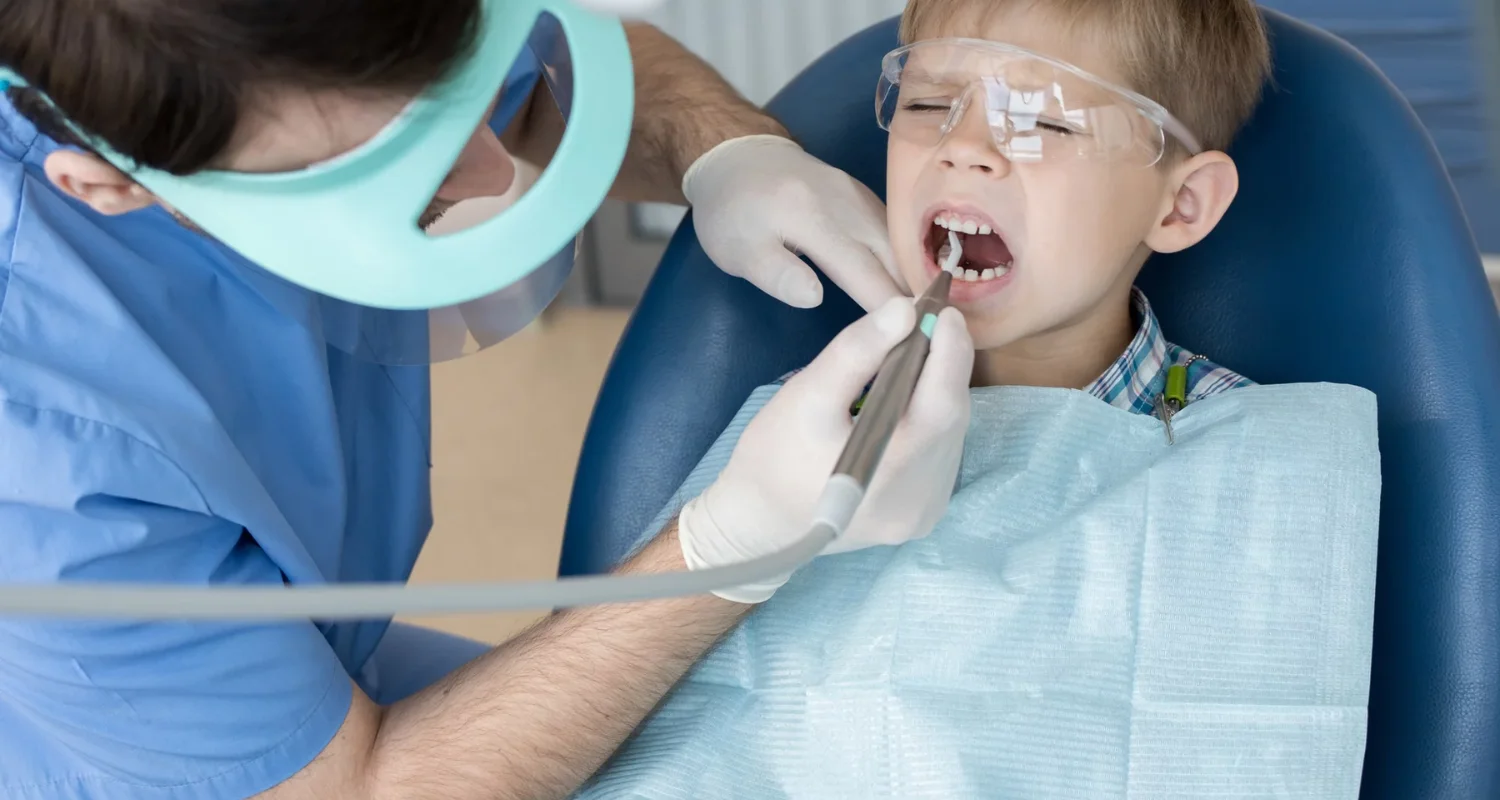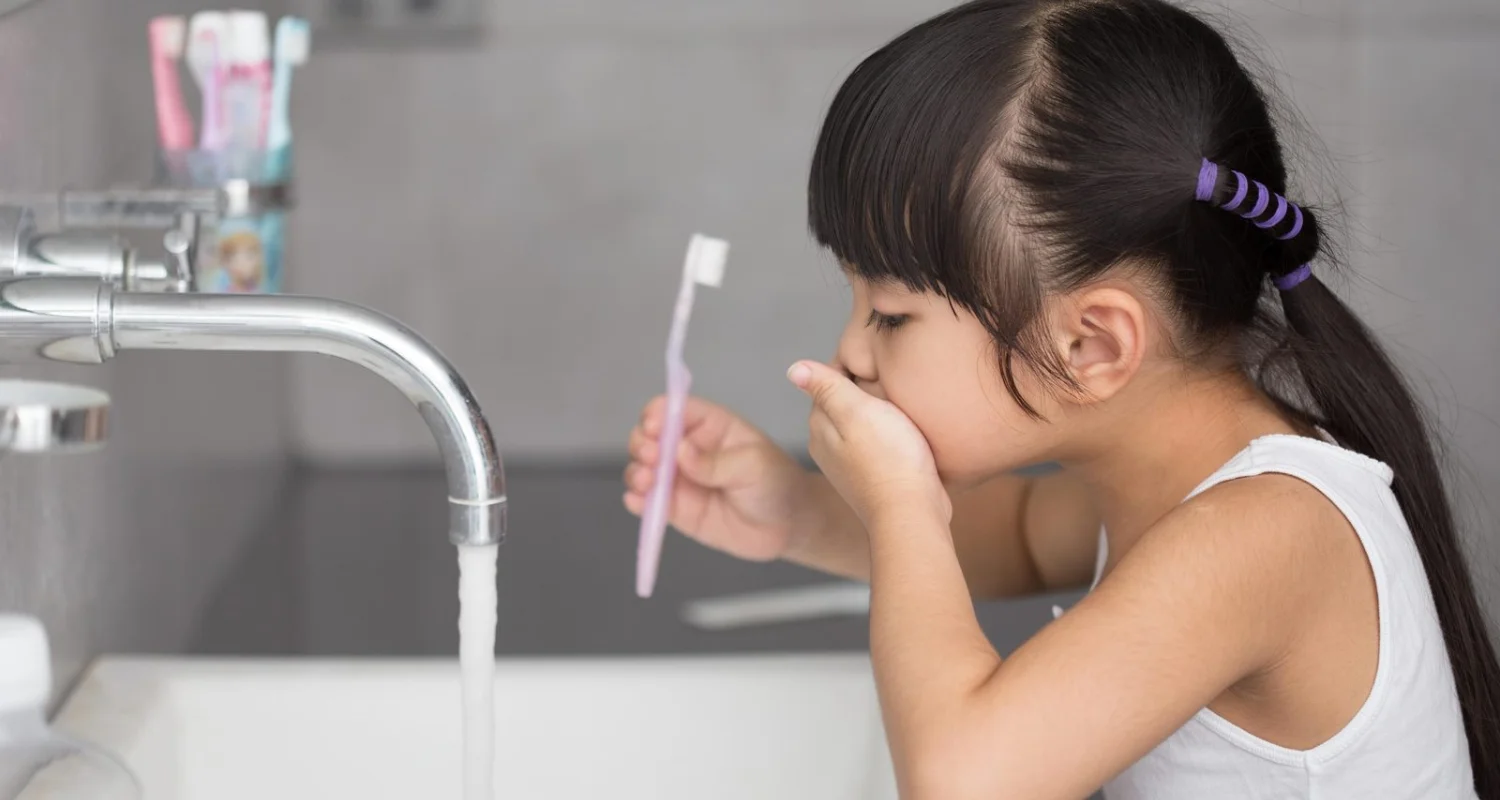Last Updated on: 13th December 2025, 08:27 am
A root canal on baby teeth is needed to treat deep cavities or infections that cause pain and damage. It saves the tooth to keep space for adult teeth, support chewing, and speech. Early treatment prevents complications and helps maintain healthy oral development.
Many parents are surprised to learn that a root canal on baby teeth, or pulpectomy, is a fairly common procedure. Although these teeth eventually fall out, keeping them healthy is crucial until they do. A baby root canal might be needed if a deep cavity reaches the nerve and causes pain or weakens the tooth’s structure. In this procedure, the infected pulp is removed and replaced with resorbable material, which helps relieve pain and preserves the tooth.
Root canal on baby teeth is especially important as these teeth hold space for the upcoming permanent dentition, support speech development, and aid in chewing. Unlike adult teeth, baby teeth have thinner enamel and larger pulp chambers, making them more susceptible to decay that can quickly reach the living tissue or nerve inside. In adult teeth, a pulpectomy is just the first step of a root canal, but in baby teeth, it serves as a complete treatment.
In this article, we’ll explore what a root canal on baby teeth involves, why it’s important for children’s oral health, and effective ways to prevent it.
When Is a Root Canal on Baby Teeth Necessary?
A root canal on baby teeth is often necessary to treat deep cavities, trauma, or infections that affect the pulp of the soft inner tissue of the tooth that contains nerves and blood vessels.
If left untreated, these conditions can cause significant pain, infection, and damage, ultimately leading to complications like abscesses or jawbone infections. Saving baby teeth until they are naturally ready to fall out is essential for a child’s oral health, as the primary teeth hold space for permanent teeth, aid in speech development, and support proper chewing.
What Conditions Require a Root Canal on Baby Teeth?
- Deep cavities: Cavities that extend to the pulp can cause severe pain and infection, making a pulpectomy necessary to remove the infected tissue.
- Trauma: Injuries, such as a blow to the face during sports, can damage the pulp and lead to inflammation or infection.
- Infection-related issues: If bacteria enter the pulp through decay or trauma, it can result in:
-Dental abscess: A painful infection at the root of the tooth that can spread to surrounding areas if untreated.
-Irreversible pulpitis: Severe inflammation of the pulp, causing significant pain and requiring pulp removal.
-Necrotic pulp: When the pulp tissue dies, it needs to be removed to prevent infection.
Why saving baby teeth is important?
- Space maintenance for permanent teeth: Baby teeth guide the alignment and positioning of adult teeth.
- Supports speech and chewing: Primary teeth are essential for proper speech development and effective chewing.
- Prevention of further damage: A root canal on baby teeth can stop infection from spreading to the jawbone, reducing the risk of abscesses and more severe complications.
Signs a Child May Need a Root Canal
- Prolonged pain: Persistent pain in a tooth could indicate pulpal infection.
- Swelling: Swelling around the affected tooth or gums is often a sign of abscess or infection.
- Sensitivity: Increased sensitivity to hot or cold food and drinks may suggest pulpal infection or inflammation.
Timely treatment of these conditions can help alleviate pain, preserve the tooth, and promote a healthier and smoother transition to permanent dentition.
Is a Root Canal on Baby Teeth a Complicated Procedure?
A pulpectomy, or a root canal on baby teeth, is a simple procedure designed for young patients. During the procedure, the dentist removes all pulp tissue from both the crown and roots and fills the tooth with a material that the body will eventually absorb. A pulpectomy alone usually pertains to baby teeth.
A full root canal on permanent teeth starts with a pulpectomy but adds a crown or filling permanently to seal the tooth.
A pulpectomy can be done in one visit if the following is followed:
- X-ray taken to see the extent of infection and shape of root canals.
- Local anesthesia given to numb the area.
- A small hole is drilled into the tooth.
- Now it evacuates the pulp using special instruments.
- Thorough cleaning of the tooth, disinfecting and preparation for filling.
- Then it is filled with resorbable material such as calcium hydroxide, iodoform pastes, etc.
On the contrary, a full root canal usually requires more than one visit. Cleaning, shaping, filling, and then sealing of the root canal system will ensue following the removal of the pulp. The final visit might be done along with temporary crowning which may incorporate a permanent filling and crown in order to establish stability.
How Long Does the Procedure Take?
A root canal on baby teeth typically takes about 30 to 60 minutes, depending on the tooth and extent of decay. During the procedure, the dentist will make the child comfortable and may use calming techniques or mild sedation if needed. After the treatment, children may experience slight tenderness, but recovery is generally quick, allowing them to resume normal activities the same or next day.
Can Baby Teeth Be Pulled Instead of Doing a Root Canal?
Dentists aim to save baby teeth rather than pulling them out, as these teeth play an important role in guiding the proper alignment of the permanent teeth and supporting speech development. Premature loss of a baby tooth can cause nearby teeth to shift, potentially leading to crowding or misalignment when adult teeth emerge.
Retaining primary teeth with a root canal helps maintain proper spacing in the mouth and supports healthy oral development until the baby teeth are ready to fall out naturally.
How to Avoid Dental Problems That Can Lead to a Root Canal on Baby Teeth?
Prevention of dental problems in children begins with good home care and healthy habits. Some important strategies are for the protection of the child’s teeth and the minimization of the chances of needing a root canal:
- Brushing tips for toddlers and young children: Educate the child to brush at least twice a day using a small, soft-bristled toothbrush. Support smaller children until they learn to brush their teeth properly and cover all surfaces of every tooth.
- Use fluoride toothpaste: Use a pea-sized amount of fluoride toothpaste to help build enamel and prevent cavities. When using toothpaste, teach children to spit out as much of the toothpaste as possible after brushing. Use under the guidance of an oral healthcare professional.
- Limit sugary food and drinks: Reduce the consumption of sugary foods and drinks that can cause tooth decay. Replace them with healthier options, such as fruits and vegetables, in addition to water.
- Frequency of dental visits: Visit a dentist for regular dental checkups every six months so they can observe your child’s oral health, clean the teeth, and prevent other issues before they worsen.
- Pit and fissure sealant application: The sealants are a layer of thin protective coating applied onto the chewing surfaces of the molars to inhibit cavity formation by blocking the entrance of food particles and bacteria.
Conclusion
In caring for baby teeth, parents lay the foundation for their child’s lifelong oral health. Root canal on baby teeth is often necessary to preserve these essential placeholders for permanent teeth, supporting healthy speech, chewing, and alignment. By following preventive steps and regular checkups, parents can help reduce the likelihood of serious dental issues and keep their child’s smile healthy, bright and straight.
Frequently Asked Questions
How common are “baby root canals” for 7-year-olds on baby teeth?
Baby root canals, or pulpectomies, are relatively common in young children, especially when deep cavities reach the tooth’s pulp, causing pain or infection. Although baby teeth will eventually fall out, maintaining their health is crucial to prevent pain and ensure they serve their essential role in guiding permanent teeth into proper alignment.
Are there cases where cavities in baby teeth do not require dental filling treatment?
Yes, not all cavities in baby teeth require fillings. Small cavities that don’t reach the tooth’s inner pulp or pose no immediate risk of spreading may be managed with preventive care and monitoring by the dentist. However, any deep cavities or those causing pain or affecting the tooth’s structural integrity typically require treatment to prevent further damage.
Is a root canal necessary for kids?
Yes, in some cases, a root canal (or pulpectomy) is necessary for children. This procedure is performed to treat infected or damaged pulp tissue, which can cause pain and lead to severe complications if untreated. Root canals on baby teeth help preserve the tooth’s function, prevent misalignment of permanent teeth, and support healthy chewing and speech development.
Is it normal to do a root canal on a baby tooth?
Yes, it is relatively normal and often recommended to perform a root canal on a baby tooth if it is severely decayed or infected. Even though baby teeth are temporary, they are essential for guiding permanent teeth into place and supporting proper speech and eating habits. Root canals in baby teeth can prevent the need for premature extraction and avoid complications from tooth loss.
What are the signs that a child may need a root canal on a baby tooth?
Signs that a child may need a root canal include prolonged pain, swelling around the tooth or gums, and sensitivity to hot or cold foods. These symptoms indicate an infection or inflammation of the tooth pulp, requiring timely dental intervention to alleviate pain and prevent further issues.
Voice and Search (Q&A)
Why is it important to save baby teeth instead of pulling them?
Saving baby teeth helps maintain space for permanent teeth, supports proper chewing and speech, and prevents misalignment or crowding of adult teeth.
How long does a root canal procedure on baby teeth usually take?
A root canal on baby teeth typically takes between 30 to 60 minutes and is usually completed in a single visit with local anesthesia.
How can parents help prevent dental problems that lead to root canals in children?
Parents can prevent dental issues by encouraging good brushing habits, limiting sugary foods, using fluoride toothpaste, and scheduling regular dental checkups.
Share
References
1. Baik (2018). Pulpotomy vs. pulpectomy techniques, indications and complications. International Journal of Community Medicine and Public Health, 5(11), 4975. https://doi.org/10.18203/2394-6040.ijcmph20184261
2. Pietrangelo, A. (2019, July 16). What you Need to Know About a Pulpectomy. Retrieved from https://www.healthline.com/health/pulpectomy#the-procedure
3. Barja-Fidalgo, F., Moutinho-Ribeiro, M., Oliveira, M. A., & de Oliveira, B. H. (2011). A systematic review of root canal filling materials for deciduous teeth: is there an alternative for zinc oxide-eugenol?. ISRN dentistry, 2011, 367318. https://doi.org/10.5402/2011/367318
4. Tafti, A., & Clark, P. (2023, July 31). Anatomy, Head and Neck, Primary Dentition. Retrieved from https://www.ncbi.nlm.nih.gov/books/NBK573074/
5. Tips for good oral hygiene and healthy smiles. (2017). https://dentistry.uic.edu/patients/oral-hygiene
-
Nayibe Cubillos M. [Author]
Pharmaceutical Chemestry |Pharmaceutical Process Management | Pharmaceutical Care | Pharmaceutical Services Audit | Pharmaceutical Services Process Consulting | Content Project Manager | SEO Knowledge | Content Writer | Leadership | Scrum Master
View all posts
A healthcare writer with a solid background in pharmaceutical chemistry and a thorough understanding of Colombian regulatory processes and comprehensive sector management, she has significant experience coordinating and leading multidisciplina...



















